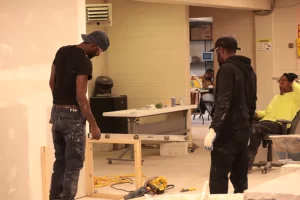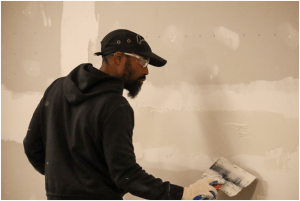Drywall, also known as wallboard or sheetrock, includes gypsum panels and is a typical construction material for interior ceilings and walls. If there is wall damage, machine installation, or a room renovation project, your drywall finishing may require removal. Efficient and safe drywall removal calls for precision and care. Here we will explain how removing drywall can be accomplished without swinging a sledgehammer in small areas or entire rooms. Your home is an area you need to look forward to after a long day. Sometimes it is essential for drywall removal to have a new start. Though it may seem like a huge undertaking, with adequate tools and our easy-to-follow tips, you can demo your area with ease. Keep in mind to follow the instructions to reduce the inhalation of dust and debris.
One of the most vital things to remember during drywall removal is to prevent cutting into HVAC vents, plumbing, and electrical platforms. Utilize a stud finder to discover any obstructions behind the wall, such as electrical fixtures and pipes. Mark the regions with tape and avoid tearing or cutting into them later.
You should avoid the spread of drywall dust, particularly in a big project that uses removing all of the drywall work from a room. Move tiny pieces of furniture outside the room and cover bigger pieces of furniture with tarps. You can also utilize plastic sheeting. Remember to use a respirator mask to safeguard yourself from drywall debris.
Also, remember that there may be screws and nails implanted into the drywall that you can remove without harming the wall. First, spread a wide putty knife flush against the wall. Then grip the nail near its ground with a pair of end-cutting pliers back and forth until the screw or nail comes out of the wall.

Use a utility knife to slash the top portion of where the molding touches the drywall. Then use a pry bar to take off the molding or baseboards that deter access to the drywall.
Sometimes you may be required to remove a somewhat small section of drywall finishing to restore water damage or establish a built-in air conditioner or another device. First of all, measure the area of drywall you require to remove and mark the proportion with a pencil. Then make the initial cut with a reciprocating saw with the help of a circular blade. Next, carefully cut the remaining hole. If the severed segment does not fall out instantly, pry it loose with a prying tool or drywall knife and throw it away.
An individual uses a claw hammer to create holes in drywall. Then use a drywall knife to cut through the joint mix at a ceiling former or wall corner to make it simpler to tear at those areas. For partial removal, dot the removal border with a saw cut and a stud. Then loosen the drywall installation and fixing along the floor with a pry bar.
You can use either the face of a hammer to punch a sequel of small holes in the drywall along the stud bays in the ceiling. After that, connect the holes to build a handhold. Dry vacuums are useful for dust accumulation. Remember to use safety gloves and goggles as they will manage the danger of getting dust and debris in your eyes.
Removing drywall repair without doing a demo of the whole wall can be achieved with the use of a magnetic ball stud finder. Extracting the nails and screws will help in removing the drywall without resulting in excess dust to dissipate everywhere. Put drywall chunks into heavy-duty garbage bags if possible. After the drywall is removed, pry loose any drywall screws or nails that stay on the studs. Use a wet or dry vacuum to collect any remaining dust from the work area.

Learning the process and tool used in removing drywall and replacing it with new drywall service has benefits over putting a new coating atop the old. Overlaying drywall can lead to clearance problems in the room, while removal provides you the chance to check the interior wall for termite damage, worn wiring, and other indications of wear and tear. Removing drywall is the initial step to rejuvenating a room.
Read More